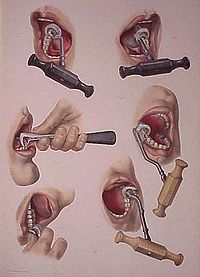
Dental key
Encyclopedia

Dentistry
Dentistry is the branch of medicine that is involved in the study, diagnosis, prevention, and treatment of diseases, disorders and conditions of the oral cavity, maxillofacial area and the adjacent and associated structures and their impact on the human body. Dentistry is widely considered...
to extract diseased teeth
Tooth
Teeth are small, calcified, whitish structures found in the jaws of many vertebrates that are used to break down food. Some animals, particularly carnivores, also use teeth for hunting or for defensive purposes. The roots of teeth are embedded in the Mandible bone or the Maxillary bone and are...
. Before the era of antibiotics, dental extraction was often the method of choice to treat dental infection
Infection
An infection is the colonization of a host organism by parasite species. Infecting parasites seek to use the host's resources to reproduce, often resulting in disease...
s, and extraction instruments date back several centuries. The dental key, (also known as Clef de Garengeot, Fothergill
Fothergill
Fothergill may refer to:*Fothergill, Cumbria, a place in England*Fothergill , people with the surname Fothergill-See also:*Fothergill gold medal, awarded triennually by the Medical Society of London....
-Key, English-Key, Dimppel Extractor or Tooth Key) was first mentioned in Alexander Monro
Alexander Monro
Alexander Monro may refer to:*Alexander Monro , Principal of Edinburgh University, 1685–1690* Alexander Monro , Scottish physician, founder of Edinburgh Medical School...
's Medical Essays and Observations in 1742, but had probably been in use since around 1730. It remained popular into the 20th century when it was replaced by the more modern forceps. Modeled after a door key, the dental key was used by first inserting the instrument horizontally into the mouth, then its "claw" would be tightened over a tooth. The instrument was rotated to loosen the tooth. This often resulted in the tooth breaking, causing jaw fractures and soft tissue damage.
The design of the dental key evolved over the years. The original design featured a straight shaft, which caused it to exert pressure on the tooth next to the one being extracted. This led to a newer design in 1765 by F. J. Leber where the shaft was slightly bent. In 1796 the claw was fixed via a swivel enabling it to be set in various positions by a spring-catch. Newer designs, such as those manufactured by medical instrument maker Charriere featured interchangeable claws. By the end of the 19th century, the introduction of forceps
Forceps
Forceps or forcipes are a handheld, hinged instrument used for grasping and holding objects. Forceps are used when fingers are too large to grasp small objects or when many objects need to be held at one time while the hands are used to perform a task. The term 'forceps' is used almost exclusively...
made popular notably by Sir John Tomes, rendered the tooth key mostly obsolete. However, a modern version of the dental key, the Dimppel Extractor, briefly revitalized its use later in the 20th century.

